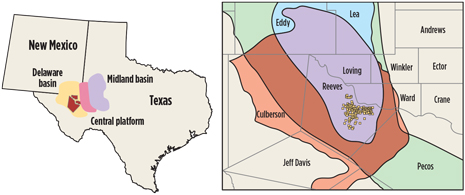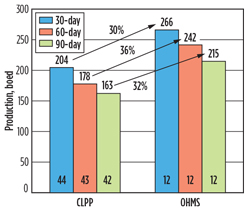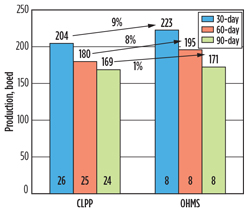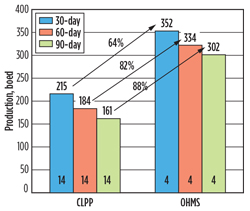Open-hole, multi-stage verticals surpass conventional plug-and-perfs in Permian basin
A comparison of production data from cemented and uncemented vertical wells in the Delaware basin area of the Permian basin showed that open-hole, multi-stage technology is a viable option for operators.
The Permian basin is one of the top five resource plays in the U.S., attracting a high volume of activity from operators. This unconventional trend consists of several stacked pay zones, and the shale and carbonate layers act as barriers to fracture growth, making well completions a challenge. While horizontal completions in the shale layers are in the initial stages, operators are successfully exploiting the reserves through vertical wells. Figure 1 illustrates the Permian basin, and, specifically, the formations in the Delaware basin that are the focus of this article.
WOLFCAMP SHALE AND BONE SPRING (WOLFBONE)Two of the target formations in the Delaware basin are the Wolfcamp shale and Bone Spring (together referred to as the Wolfbone), Fig. 2, which deliver a pay zone thickness of approximately 1,000 ft to 1,500 ft. The Bone Spring is a thick sequence of interbedded sandstones, carbonates and shale, at depths ranging from approximately 6,000 ft to 13,000 ft. Stratigraphically, each layer of the Bone Spring comprises a sand and carbonate layer, both of which contribute to production. Third Bone Spring sandstones range in porosity from 7% to 18%, and permeability is 2.0 mD or less (Montgomery, 2004).
The Wolfcamp shale, situated below the Bone Spring, acts as both a source rock and a reservoir, with an estimated 3 billion bbl of oil (Beckwith, 2013). While there are pockets of high porosity and permeability in the trend, the majority of the reservoir interval is of lower quality, with porosity and permeability ranges from 5% to 8%, and 0.001 mD to 1.0 mD, respectively (Fairhurst and Hanson, 2012). Originally, exploration focused on the Wolfcamp sandstone reservoirs below, and the Third Bone Spring sandstone reservoirs above the Wolfcamp shale, which is now the focus of development efforts (Fairhurst and Hanson, 2013). Historically, the major operators were not involved with the play, but now, with the stacked, multi-play reservoirs, the potential has attracted more attention. COMPLETION METHODSEven though the Permian basin is a mature exploration area, completion of the thick shale intervals requires investigation into new methods and technologies to access the remaining hydrocarbons that are more challenging to exploit. To date, open-hole, multi-stage systems (OHMS) and the conventional cemented liner, plug-and-perf (CLPP) method are the two vertical completion methods that have been used to gain access to hydrocarbons in this area. These two methods are compared in this article, to highlight OHMS as a long-term solution for operators completing vertical wells in a stacked pay. The production, operational and cost comparisons of the two completion methods provide theoretical and practical arguments to assist in designing an optimal completion. CLPP completions usually consist of the wellbore being cased and cemented, followed by limited-entry stimulation techniques (cluster fracturing) through the use of composite bridge plugs, set on wireline or coiled tubing (CT), and perforating (Blanton and Mackenzie, 2006). The bridge plugs provide the mechanical diversion inside the liner, to effectively stimulate each selected zone, while the perforations provide access to the formation. This process is then repeated for the number of stimulations desired for the wellbore. After all the stages have been completed, CT or a workover rig is used to drill out the composite bridge plugs and establish access along the wellbore. Although effective, the multiple interventions, perforating guns and deployment of fracturing equipment required for each stage can be inefficient, from both a time and cost perspective. OHMS systems use hydraulically-set, external mechanical packers to isolate sections of the wellbore. These packers typically have elastomer elements that extrude to seal against the wellbore. The OHMS system is run in hole by spacing tools out on the production liner. When the system reaches TD, the packers can be set, and the drilling or workover rig can be moved to a different location. After installation, the toe fracturing port is opened hydraulically (at a specific pressure), and subsequent sleeves are opened by dropping size-specific actuation balls into the system, to hydraulically shift the sleeve and expose the port. The balls create internal isolation from stage to stage. Once stimulation treatment is complete, the well can be flowed back immediately, and production can be brought online. The major advantage of OHMS is that fracture treatments can be performed in a single, continuous pumping operation, without the need for CT or wireline. CASE STUDYThis operator wanted to effectively complete vertical wells in the Wolfbone, while keeping costs low. Initially, the operator used the standard, cemented liner plug-and-perf stimulation method; however, problems with wireline guns and issues while fishing plugs occurred, resulting in additional time and labor costs. The area is abnormally pressured, making fishing operations even more complex, because a snubbing unit is required. The operator was also looking to exploit the higher porosity and permeability of the sandstone layers, as well as any natural fractures present. The operator chose to run the proprietary Packers Plus StackFRAC HD open-hole system in its vertical wells, as it had experience with OHMS systems from work in other, predominantly horizontal, unconventional plays (Lohoefer et al., 2010). After several wells were completed with these systems, stimulated and put on production, the operator conducted a 30-, 60- and 90-day production analysis, as well as a time-and-cost comparison of the two completion methods, to determine a long-term solution for completing vertical wells in this unconventional play. Twelve vertical wells completed with StackFRAC HD technology were compared to 44 plug-and-perf wells in Reeves County, Texas. Production was studied in two ways: overall production and output by area. Overall production examined all vertical wells completed by the operator in Reeves County. The overall results for the 30-, 60- and 90-day studies are provided in Fig. 3, including the number of wells compared in each case. Output by area removed any location bias by looking at two areas separately: the Core and the Worsham areas, Fig. 4. The Core area is centrally located in the basin, where the majority of the activity has taken place, and the Worsham area is deeper in the basin with better porosity.
PRODUCTION RESULTSCumulative, overall production from the vertical wells completed with the Packers Plus technology was up to 36% higher than cumulative overall production in the plug-and-perf wells. After the initial month, the 12 StackFRAC HD wells had a 30% production advantage over the 44 plug-and-perf wells, producing 266 boed, compared to 204 boed. This trend continued, and after three months, the StackFRAC HD wells outperformed the plug-and-perf wells by 32%: 215 boed versus 163 boed. The wells completed with Packers Plus OHMS systems in the Core area initially had a production advantage over plug-and-perf wells, but this difference tapered off after three months. After the first month in the Core area, StackFRAC HD wells produced at a rate 9% higher than plug-and-perf wells (223 boed versus 204 boed, respectively). However, only a 1% production difference was observed between StackFRAC HD and plug-and-perf wells after three months (171 boed versus 169 boed), Fig. 5.
Differences in production were significantly higher in the Worsham area, where StackFRAC HD wells outperformed plug-and-perf wells by 64% after the first month (352 boed versus 215 boed), Fig. 6. This trend continued after three months, with an 88% production difference between the two completion methods (302 boed versus 161 boed).
It should be noted that both areas have virtually identical gross and net pays, average porosity, water saturation and other measurable geological reservoir parameters. However, the Worsham area performed better than the Core area when completed with OHMS systems. One possible reason for this would be increased natural fractures in the Wolfcamp. The higher mud weights required, and more/larger gas flares recorded in mud logs, combined with higher gas-oil ratios and flowing pressures, indicate that very small, but pervasive, natural fractures were likely created during hydrocarbon generation in the Worsham area of the Wolfcamp. These natural fractures significantly increase average permeability, and, thus, increase production. Unlike cemented completions, StackFRAC HD open-hole technology retains connectivity of natural fractures to the wellbore. After fracture flowback, results for these wells displayed higher flowing pressure and significant oil production within the first 24 hr, whereas CLPP wells had lower flowing pressures and no oil production for five to six days. The quicker appearance of oil production may be attributed to unstimulated natural fractures that were not filled with cement. Although the natural fracture system in the Core area is not as extensive as in the Worsham area, StackFRAC HD wells still performed better than CLPP wells, albeit by a smaller margin. Additionally, the Worsham area is considered to be a more reliable comparison of production results than the Core area, because the stimulation parameters in the former are more similar between the two completion methods that were analyzed. The Core area was completed prior to the Worsham area, while operators were still determining the optimal stimulation design. TIME/COST ANALYSISOHMS systems and plug-and-perf capital costs were determined to be approximately equal, but there were benefits from completing the wells more quickly with the StackFRAC HD system. A comparison analysis shows that stimulation time was reduced from four days with the plug-and-perf technology, to two days with the StackFRAC HD system, saving the operator 20% on stimulation costs. Although the OHMS system requires higher initial costs, due to the packer system, itself, the additional costs are offset by saved time and other equipment requirements associated with the plug-and-perf method, such as the perforation guns and wireline plugs. In addition to eliminating two days of stimulation operations, an added benefit was the increased availability and flexibility of the service company’s hydraulic fracturing treatment equipment schedule. Because a fracture fleet was only needed for two days, instead of the average four-day period, fracturing service companies were able to do more fracture jobs, with the same amount of equipment and personnel, in the same amount of time. As a result, the operator benefited from an effectively increased number of fracture dates available from the service companies. STIMULATION OPERATIONSDelaware basin operators have generally been trending toward a specific fracture methodology, often just modifying fluid and proppant volumes, and stage and cluster spacing, without stepping outside of the plug-and-perf method. Proppant amounts ranging from 750,000 lb to 3.2 million lb have been used, depending on the desired fracture geometry in a given interval. This operator used 1 million lb to 1.5 million lb of proppant, pumped through 11-stage StackFRAC completion systems that spanned approximately 1,200 ft of the Wolfcamp and Bone Spring intervals. The process of when to drop the balls, to achieve a balance of high near-wellbore conductivity and proper zonal isolation, has also been tested in these wells. If the ball is dropped too early, then there is a risk of landing the ball in the proppant slurry, which does not allow for proper zonal isolation. Conversely, if the ball is dropped too late, the overflush will decrease near-wellbore conductivity. An effective process for achieving a good balance of both in these wells has been to drop the ball 50 bbl after the last of the proppant. The combination of the ball’s weight with the pump rate lands the ball just behind the proppant, thus diminishing the chance of overflushing the interval. A linear or crosslinked gel spacer is also pumped to reduce the likelihood of the ball outrunning the proppant. The operator was initially concerned that using an open-hole system in vertical wells would not achieve proper zonal isolation, due to fracture geometry causing cross-flow between stages. Stage spacing has hovered around the 100-ft mark, further increasing the concern about communication between zones. In order to test this, a radioactive tracer was run in one well. Tracer logs displayed multiple fracture initiations in a single stage, and isolation at the packers, which mitigated the operator’s concern regarding uncontained vertical height growth when using an open-hole system in a vertical well completion. CONCLUSIONS
ACKNOWLEDGEMENT This article is adapted from SPE paper 168643, presented by the authors at the SPE Hydraulic Fracturing Technology Conference in The Woodlands, Texas, Feb. 4–6, 2014. The authors thank the management of Eagle Oil & Gas and Packers Plus Energy Services for granting permission to publish this article. REFERENCES
|
- Applying ultra-deep LWD resistivity technology successfully in a SAGD operation (May 2019)
- Adoption of wireless intelligent completions advances (May 2019)
- Majors double down as takeaway crunch eases (April 2019)
- What’s new in well logging and formation evaluation (April 2019)
- Qualification of a 20,000-psi subsea BOP: A collaborative approach (February 2019)
- ConocoPhillips’ Greg Leveille sees rapid trajectory of technical advancement continuing (February 2019)









